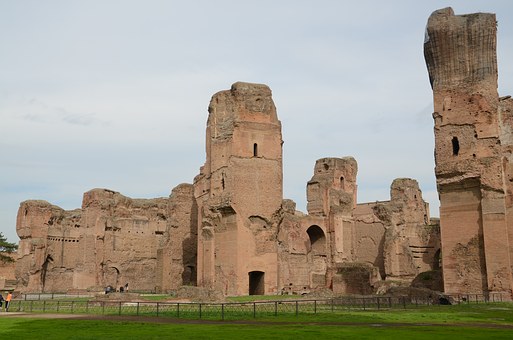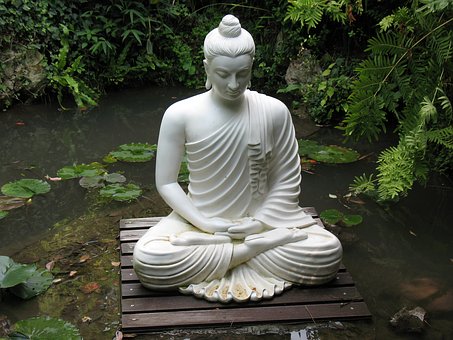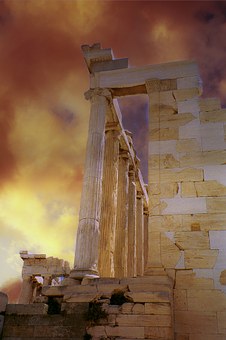Prague Travel: Two Of Prague's Gems: Strahov Monastery And Prague Castle

At the end of my delicious lunch at La Rotonde
, the Art Deco restaurant at the Radisson Blu Alcron Hotel, my personal tour guide for my walking tour of Prague came to pick me up. Petra Bedlasova is a historian, artist and photographer, and she is also one of the expert guides for Prague Walks, one of Pragues most well-known tour guiding companies.Just steps from the hotel we entered one of the local landmarks just off Wenceslas Square: the Lucerna Palace is a passage that connects Vodickova and tepnsk streets, a true entertainment complex that houses many retail stores, restaurants, a movie theatre, a music bar and the prestigious Lucerna Grand Hall, one of Pragues most famous concert halls. The complex was built between 1907 and 1921 and the first part of the arcade was opened in 1907. Opened in 1909, the Lucerna Cinema was the first permanent cinema in Bohemia, and held the screening of the first talking movie in 1929. Various Art Nouveau and Art Deco details adorn this complex, and one of the most visually stunning details is an upside down horse by Czech sculptor David Cern. It has been hanging from the buildings glass-covered dome since 1999.
We stepped out of the building on the west side and continued through another passageway towards a small public park called the Franciscan Gardens, a secluded oasis in the middle of the city which feature a rose garden where we stopped to look at a very tall Gothic cathedral. Petra explained we were looking at the Church of Our Lady of the Snows. The church was planned in the 14th century and was never completed, and at 34 metres, its vaulted ceiling is the highest in Prague, even higher than that of famous St. Vitus Cathedral. Exiting from the rose garden we stepped into the church and I was impressed by the enormous altar, at 29 metres the highest in the city.
Today this church is still the heart of a Franciscan monastery, which opened in the 1990s after having been shut down by the Communist regime in 1950. A few steps further we went into the monastery, and in one of the monasterys arcaded walkways an exhibition of sculptures was being set up. The life-size sculptures were quirky depictions of human scenes and I snapped a few pictures of them before we got kicked out.

Walking further west we stopped at the Palac Adria, a stunning example of European Art Deco. Built originally in 1923 and 1924 for a major insurance company, its inside features a passage that connects two major streets. The floor mosaics, the brass store windows and doors, the brass chandeliers and the wall sculptures are great samples of high Art Deco architectural details. After being renovated in 1996 and 1997, the building today holds apartments, offices, a theatre club, a gallery and a restaurant, and the faade showcases the rondo-cubist style.
Since we were trying to explore Pragues famous Castle Hill, we now hopped into a streetcar that started taking us past the National Theatre across the Vltava River into the Mala Strana (Lesser Town or Little Quarter) District and from here on a curvy track up onto Castle Hill. Petra explained that Prague Castle is the largest castle complex in the world and covers more than 1100 years of history.
Our first stop on the hill was Strahov Monastery, which found its origins in a Romanesque stone monastery for the Premonstratensian order in 1182. An earlier building had been there since 1140 AD. Over the centuries various reconstructions happened, and today the monasterys appearance is primarily Baroque. The Basilica of Our Lady dates from the second half of the 1700s and is an example of high Baroque.
Petra took me inside the complex to the Philosphical Hall, a baroque library dating from 1782 which contains more than 42,000 books covering the topics of astronomy, history, philology, philosophy and mathematics. A stunning ceiling fresco depicts the history of mankind, allegorical images of philosophy and knowledge, starting from Ancient Roman times. Further down the corridor is the older Theological Hall, completed in 1679, which contains more than 18,000 religious books. At the end of the corridor is an optical illusion: a trompe loil mural depicting a deeper column-fringed portico.
From the gardens on the eastern side of Strahov Monastery we had a phenomenal view of the entire City of Prague, with the Prague Castle complex to the left, the Vltava River in the middle, and the modern (in)famous television tower on the horizon, a modern structure started during the Communist regime and finished in the 1990s that is not much beloved by the residents. On the right hand side we were looking at Petrin Hill whose most well-known landmark is a miniature version of the Eiffel Tower, exactly one fifth the size of the real Eiffel Tower. It opened in 1891, two years after the Eiffel Tower in Paris. Looking over the city it was plainly obvious why Prague enjoys the moniker City of 100 Spires.
We strolled back over to Castle Hill and stopped on the square behind Cernn Palace, the longest Baroque building in Prague which now houses the Ministry of Foreign Affairs and also served as SS headquarters during World War II. On the east side of the square is the Loreto, Pragues most renowned place of pilgrimage, completed in 1626 at the order of a Czech aristocrat who was eager to promote the legend of the Santa Casa of Loreto, said to be the house where the Archangel Gabriel told Mary about the future birth of Jesus. The original house was located in the town of Loreto in Italy, but 50 replicas of the Loreto were built in Bohemia and Moravia. The baroque bell tower of the Loreto holds a carillon with 30 bells that were cast in Amsterdam in 1691.
The Capuchin Monastery, founded in 1600, is located on the north side of the square and still displays some canon balls embedded in the faade. From here we walked down the hill to Hradcany Square, just outside the western gates of Prague Castle. Several palaces and historic buildings surround the square, including the Salmov Palace, the Schwarzenberg Palace, the Carmelite Monastery, Hradcany Town Hall, Tuscany Palace, Martinic Palace and Sternberg Palace.
The newly renovated Schwarzenberg Palace dates from the late 1500s and features an amazing Renaissance-era sgraffito faade. Columns remembering the Black Plague adorn the centre of the square in front of the main entrance to Prague Castle. Late 19th century street lighting has been restored with historically accurate gas lighting.
At the entrance of Prague Castle we witnessed the Changing of the Guards, an hourly ritual that attracts large crowds of onlookers. Prague Castle is the citys number 1 tourist attraction and it has magically survived countless fires, invasions and even world wars. Founded around 860 AD, various Czech dynasties occupied this expansive castle complex that was reconstructed throughout the centuries. The Romanesque style was introduced in the 13th century, Gothic rebuilding took place under Charles IV in the 13th century, and an enormous fire destroyed a large portion of the complex in 1541.
Habsburg Emperor Rudolf II introduced Renaissance architecture to the castle in the late 16th century, and Austrian Empress Maria Theresa initiated a rebuilding in Baroque style in the second half of the 18th century and gave the entire complex a unified appearance. Since 1918 Prague Castle is also the official residence of the president of the Republic. We passed through two baroque courtyards to the front faade of the St. Vitus Cathedral, the largest and most important church in the Czech Republic. Saints, kings and princes have been buried here, and the kings of Bohemia were crowned here until 1836.
My expert guide Petra explained that St. Vitus Cathedral was built in the Gothic style, and although construction of this landmark began in 1344, it was not finished until 1929. The western faade of the towers indeed show many 20th century details including images of the architects. Starting with the founding of a small round church by St. Wenceslas in the 9th century, St. Vitus is the third church in this location and a strong symbol of Czech nationalism. Upon entering the cathedral, Petra explained that the eastern part of the cathedral is medieval while the western part was completed in the 20th century. To the untrained eye it is very difficult to discern a difference, but the colourful stained glass windows by Alfons Mucha are a magnificent example of early 20th century Art Nouveau. Czech artist Frantisek Kysela designed the rose window on the Western front between 1925 and 1927.
In a walk through the cathedral Petra pointed out the tombs of Habsburg monarchs in the centre of the cathedrals medieval portion. Most of the Habsburgs are buried in Vienna, but these family tombs were an exception. A wooden carved map of Prague shows the citys layout in the early 17th century. It is possible to walk behind the altar, past the Chapel of St. John the Baptist and the Chapel of the Holy Relics. Petra pointed out a bigger than lifesize sculpture of St. John of Nepomuk which is made of solid silver. This saint is also a national saint of the Czech Republic and an important symbol of Czech Catholicism.
The masterpiece of the cathedral is the St. Wenceslas Chapel, created in the 14th century by Charles IV to honour St. Wenceslas, patron of the Czech lands. The richly decorated chapel was built over the saints grave and the colourful walls are covered by semi-precious stones of Czech origin. The rest of the wall was later covered with paintings of the legend of St. Wendeslas.
Back outside the cathedral Petra showed me a fenced off area underneath the cathedral that holds excavations of two earlier churches: an early 10th century church dedicated to St. Wenceslas, and a bigger church from the 11th century. The third castle courtyard that we were now standing in was constructed in the late 18th century. Images outside the cathedrals Golden Portal, located on the south side, consist of a mosaic depicting the last judgment. Mosaics are rather atypical for a Central European church as they can mostly be found on Italian and Byzantine churches.
From the third courtyard we walked downhill along Jirska Street, past St. Georges Convent and the Lobkowicz Palace and we exited the walled castle compound on the east side where we witnessed another Changing of the Guards ceremony. A lookout point beside the fortification walls provided us with an amazing panorama over the city and the vineyards that stretch out along the southern flanks of Castle Hill.
From here we walked down the hill towards the Malostranska subway station where we found a nice outdoor caf and capped off our walking tour with a drink and a crepe. I thanked Petra sincerely for her time and for sharing her knowledge of Prague with me before we ended the tour around 6 pm.

Now by myself, I took a nice walk along the banks for the Vltava River to the Ivanesuv Bridge from where I had an excellent view south towards the famous Charles Bridge.It felt like I was looking at a postcard from this vantage point, which provided a gorgeous panorama of the Charles Bridge and the Old Town Bridge Tower.
I continued my stroll through the narrow cobble-stoned streets of Mala Strana, the Lesser Town district on the west side of the river and came across the Franz Kafka Museum. It was now too late to go inside the museum but I enjoyed the pleasant courtyard and was most entranced by two sculptures of peeing men with swiveling hips. The sculptures most definitely had tourists puzzled and chuckling.
On my walk back towards Wenceslas Square I strolled past several Prague landmarks, including Old Town Square, the Powder Tower and Municipal House. Once arrived on Wenceslas Square I looked towards the eastern end of the square. The Czech National Museum, located on a hill, was overlooking this large public space, tinged in beautiful dark orange from the sunset. The normally grayish-brown building looked as if it were glowing in dark shades of orange.
by: Susanne Pacher Holiday in Gerona – have Preparations Ahead in Time!!! San Francisco Travel: A Culinary Tour Through North Beach San Francisco Travel: A Ride Through Golden Gate Park And Dinner At Colibris San Francisco Travel: An Interview With San Francisco Tourism - Part I San Francisco Travel: Downtown Luxury At The Handlery Hotel And Exotic Entertainment At Asia Sf San Francisco Travel: The Queen Anne Hotel & Fishermans Wharf The Most Important Thing To Have When You Travel! San Francisco Travel: Biking Across The Golden Gate Bridge & Dinner At Mccormick & Kuletos Air Travel Discount Fares Are Available Now! Why Patriotic American Indian Miners Deserve To Receive Compensation A comfortable and pleasant trip to Barcelona Villacentre.co.uk : Going To Portugal - Go To Albufeira Villa Holidays Honeymoon Trip